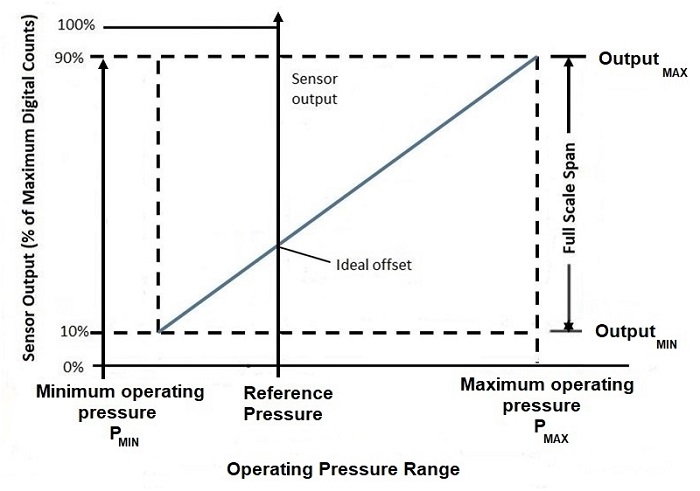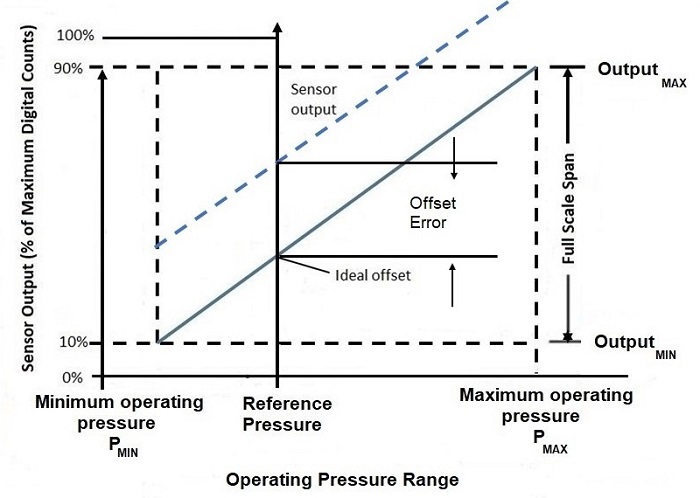By Jack Shandle, contributing editor
As pressure monitoring systems become more sophisticated, auto-zero calibration is becoming a critical technology for a growing number of applications. Common medical applications that demand high accuracy include non-invasive blood pressure monitors and miniature pumps. Another new medical application is wound therapy, in which controlled negative pressure over the wound promotes healing. Auto-zero calibration can also maintain a consumer product’s accuracy for its lifetime across a range of consumer and commercial appliances, including coffee makers, dishwashers, and washing machines.
Regardless of the application, auto-zero calibration begins by sampling an output at a known reference point. Software running on a signal-conditioning ASIC embedded in the sensor can then adjust the output to the correct pressure. The key concept in this process is the ideal transfer function.
An ideal transfer function algorithmically describes the relationship between operating pressure and the sensor’s digital output over the sensor’s operating range. Fig. 1 shows the ideal transfer function of a digital sensor. It also shows the ideal offset, which is the correct output at the pressure that is used as a reference in auto-zero calculations.

Fig. 1: Pressure sensors typically display a linear transfer function.
A variety of real-world conditions alter the ideal transfer function and create an offset error. These conditions include normal part-to-part variation and product aging. Fig. 2 shows an example of error offset.

Fig. 2: Offset error is the difference between the ideal and real-world transfer functions.
Auto-zero basics
Sensor manufacturers typically calibrate the devices in the factory to achieve highly accurate outputs, but all sensors experience some offset error once they are in the field. Fortunately, these recurring errors can be mitigated by the end user.
Because the auto-zero calibration is implemented in software, it can be performed after the sensor is deployed to the field — and this is highly recommended. When “in-situ” correction is not feasible, auto-zero calibration should be performed after factory calibration — but before deployment. This eliminates errors caused by the stress of mounting the device on the circuit board as well as any errors caused by factory calibration.
There are two common scenarios for in-field calibration: At fixed time intervals and when the system detects a temperature change. The two options are not mutually exclusive. Periodic calibrations are particularly important in ultra-low-pressure applications. The reason: Sensors that operate at or below 1 psi are inherently more likely to experience an offset error due to pressure and environmental stress. Temperature-triggered calibrations are recommended because temperature changes are the single major contributor to errors.
Before giving an overview of implementing auto-zero calibration techniques, it is worth enumerating several of the most important sources of offset error in pressure sensors. Normal-part-to-part variation and aging have already been mentioned.
Stress errors are caused when soldering the devices, or by the use of adhesives to attach the sensor to packaging, or when integrating the sensor into the pneumatic system. Environmental conditions such as temperature variations, humidity, and pressure also contribute to offset error. Even small changes in power supply voltage and unavoidable variations related to device fabrication and factory calibration can skew the output values.
For system designers, the good news is that their combined effect does not substantially change the transfer function’s linearity. It is still virtually a straight line. This accounts for the effectiveness of the auto-zero calibration technique.
It should be noted that while auto-zero calibration is a valuable strategy for gauge and differential pressure measurements, it is difficult to implement for sensors that measure absolute pressure (a vacuum source is required) and is, therefore, not recommended.
Auto-zero calibration is essentially an algorithmic process executed by firmware in an embedded ASIC. A detailed explanation is beyond the scope of this article. A full description, including sample code, can be found in the Tech Note Auto-Zero Calibration Technique for Pressure Sensors. An overview of the procedure follows:
Auto-zero calibration methodology starts with measuring and recording a reference pressure under known environmental conditions. It is a good practice to use a reference pressure as close to zero as possible. The process also requires knowing the minimum and maximum operating pressures and their corresponding digital outputs. Because the ideal and real-world transfer functions are both linear, the offset error at the reference pressure provides the offset error at any pressure within the operating limits.
Equation 1 describes the ideal transfer function of a pressure sensor:

Where:
Output = The output reading at any given pressure
Outputmin = Ideal output reading at minimum operating pressure
Outputmax = Ideal output reading at maximum operating pressure
Pmin = Minimum operating pressure
Pmax = Maximum operating pressure
Since the goal is to capture a pressure reading, Equation 1 can be rewritten as Equation 2 below:

It is good practice to take multiple readings and average them as opposed to depending on a single reading.
The auto-zero value is obtained by subtracting the average of the measured pressure values from the known reference pressure. Now that the auto-zero value is known, it can be used to adjust for errors as follows:
- Take a sensor reading.
- Calculate the pressure using the Equation 2.
- Subtract the auto-zero value from the measured value to arrive at the corrected value.
Conclusion
Auto-zero calibration solves the problem of pressure sensors losing accuracy after they leave the manufacturer. It is an algorithmic solution that is easy and relatively inexpensive to implement because it employs a simple ASIC and a few lines of code. The technology is particularly valuable for a growing number of pressure sensor applications that call for greater accuracy and measurement stability than in the past.
Related articles
Go inside Fluke’s electrical metrology lab
Choosing the right pressure sensors for engine test
Automotive pressure sensor calibration
Compensation is Critical in Fitting Analog Pressure Sensors to the Application
Advertisement
Learn more about Electronic Products Magazine





